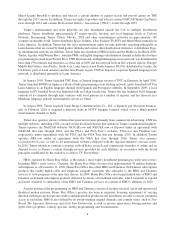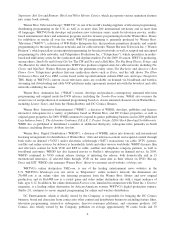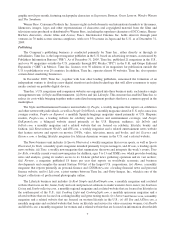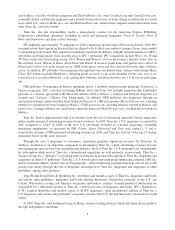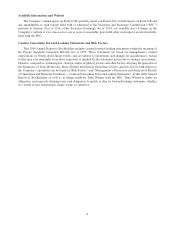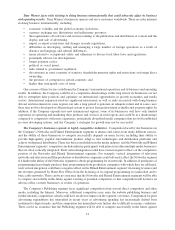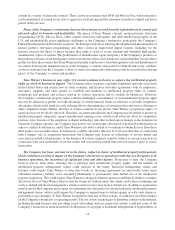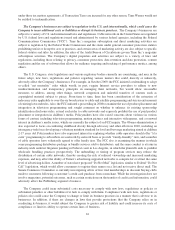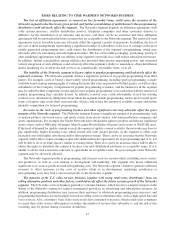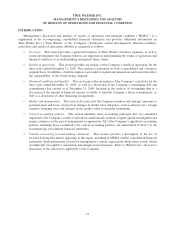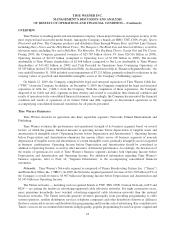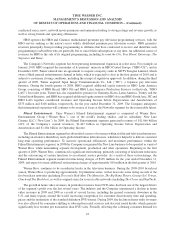Time Magazine 2009 Annual Report Download - page 25
Download and view the complete annual report
Please find page 25 of the 2009 Time Magazine annual report below. You can navigate through the pages in the report by either clicking on the pages listed below, or by using the keyword search tool below to find specific information within the annual report.existing or potential competitors or that competition will not have an adverse effect on its business or results of
operations.
The Company faces risks relating to competition for the leisure and entertainment time of consumers, which
has intensified in part due to advances in technology and changes in consumer behavior. The Company’s
businesses are subject to risks relating to increasing competition for the leisure and entertainment time of consumers
and this competition may intensify further during economic downturns. The Company’s businesses compete with
each other and all other sources of entertainment, news and other information, including broadcast television, films,
the Internet, home video products, interactive videogames, sports, print media, live events and radio broadcasts.
Technological advancements, such as video-on-demand, new video formats and Internet streaming and
downloading, have increased the number of media and entertainment choices available to consumers and
intensified the challenges posed by audience fragmentation. The increasing number of choices available to
consumers could negatively affect not only consumer demand for the Company’s products and services, but
also advertisers’ willingness to purchase advertising from the Company’s businesses. If the Company does not
respond appropriately to further increases in the leisure and entertainment choices available to consumers, the
Company’s competitive position could deteriorate, and its financial results could suffer.
The popularity of the Company’s content and other factors are difficult to predict and could lead to
fluctuations in the Company’s revenues, and low public acceptance of the Company’s content may adversely
affect its results of operations. The production and distribution of television programming, films, interactive
videogames, magazines and other content are inherently risky businesses largely because the revenues derived from
the production and distribution of such content, as well as the licensing of rights to the intellectual property
associated with such content, depend primarily on its acceptance by the public, which is difficult to predict. Public
acceptance of new, original television programming and new theatrical films and interactive videogames that are
not part of a franchise is particularly difficult to predict, which heightens the risks associated with such content. In
addition, due to the decline in the sales of DVDs, the success of a theatrical film is much more dependent on public
acceptance at the box office. The commercial success of a television program, film, interactive videogame,
magazine or other content also depends on the quality and acceptance of other competing content available or
released at or near the same time, the adequacy of efforts to limit piracy, particularly of films still in theatrical
distribution, the availability of alternate forms of entertainment and leisure time activities, the ability to develop
strong brand awareness and target key audience demographics and anticipate and adapt to changes in consumer
tastes and behavior on a timely basis, general economic conditions and other tangible and intangible factors, many
of which are difficult to predict. In addition, in the case of the Turner Networks, the popularity of their syndicated
and original programming is a factor that is weighed when determining their advertising rates, and, as a result, poor
ratings in targeted demographics can lead to a reduction in pricing and advertiser demand.
Historically, there has been a correlation between a theatrical film’s domestic box office success and
international box office success, as well as a correlation between box office success and success in subsequent
distribution channels. Consequently, the underperformance of a film, particularly an “event” film (which typically
has high production and marketing costs) or a film that is part of a franchise, can have an adverse impact on the
Company’s results of operations in both the year of release and in the future, and may adversely affect revenues
from other distribution channels, such as home entertainment and pay television programming services, and sales of
interactive videogames and licensed consumer products based on such film.
Sales of DVDs have been declining, which may adversely affect the Company’s growth prospects and results
of operations. Several factors, including weak economic conditions, the maturation of the standard definition DVD
format, piracy and intense competition for consumer discretionary spending and leisure time, are contributing to an
industry-wide decline in DVD sales both domestically and internationally, which has had an adverse effect on the
Company’s results of operations. DVD sales have also been adversely affected as subscription rental and discount
rental kiosks, which generate significantly less revenue per transaction than DVD sales, have captured an increasing
share of consumer transactions and consumer spending. DVD and Blu-ray Disc sales also may be negatively
affected as consumers increasingly shift from consuming physical entertainment products to digital forms of
entertainment. The media and entertainment industries face a challenge in managing the transition from physical to
electronic formats in a manner that continues to support the current DVD and Blu-ray Disc business and their
relationships with large retail customers and yet meets the growing consumer demand for delivery of entertainment
13



